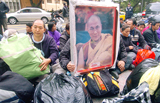Tibetan refugees yesterday threatened to stage another sit-in if the Mongolian and Tibetan Affairs Commission (MTAC) refused to grant them residency permits as promised.
Tibetan Welfare Association chairman Jamga (蔣卡) said that although the government had promised to give his compatriots legal residency status, it was now tightening application criteria, making it difficult for them to obtain permits.
“We were overjoyed when the Immigration Act [入出國及移民法)] was amended before the Lunar New Year, making it possible for us to get permits, and President Ma Ying-jeou [馬英九] also said that he cared about us and would help us,” Jamga told reporters.

PHOTO: CHANG CHIA-MING, TAIPEI TIMES
“However, after several explanatory meetings, more and more of us have been disqualified from obtaining permits for various reasons. We don’t know how many people will be granted residency in the end and feel cheated by the government,” he said.
Over 100 Tibetan refugees without legal status staged a sit-in demonstration at Liberty Square last December, asking the government to grant them asylum. The demonstration ended when the refugees received temporary residency permits in January.
Many of the Tibetan refugees crossed through the Himalayas to Nepal and India before arriving in Taiwan using forged Nepalese or Indian passports.
The amended law stipulates that the refugees must provide legal documents to prove their identity as Tibetans, Jamga said.
The document can be either the applicant’s birth certificate (or that of his/her parents), passport, Indian Identity Certificate (IC, issued by the Indian government to stateless refugees) or their Independent Book (commonly known as the Green Book, a document proving they pay taxes to the Tibetan government in exile in India), Jamga said.
“But while constantly moving, many of us have lost our documents or never had such documents [to begin with],” he said.
In addition, Jamga said that while National Immigration Agency (NIA) officials had told them in their first meeting that holders of Indian ICs would get priority, in the third meeting officials said those whose Indian ICs were still valid would be repatriated to India immediately.
“This terrifies us; if we are sent back, we may face imprisonment or even execution,” he said.
Even without being repatriated, without legal residency the refugees have no right to work, said Awansangdan, another Tibetan.
“We are now having difficulty buying food and paying rent. We have relied on donations from our Taiwanese friends, but we are at the end of our resources. We are pleading for the government to give us residency,” he said.
In response, MTAC Secretary-General Chien Shih-yin (錢世英) said that the priority was to help the refugees stay in Taiwan legally, but it would take time.
“The commission has employed very loose criteria for residency application ... I understand that [the refugees] have been through a lot, but the commission wants them to attain residency status legally so they must provide something [as opposed to verbal promises] to prove their identities,” Chien said.
Commission staffers have been working overtime since the Lunar New Year to help the refugees, Chien said, but the whole process will take a few months.
“There will be no immediate repatriations,” Chien said. “There may have been misunderstandings between the refugees and frontline staff.”

ALIGNED THINKING: Taiwan and Japan have a mutual interest in trade, culture and engineering, and can work together for stability, Cho Jung-tai said Taiwan and Japan are two like-minded countries willing to work together to form a “safety barrier” in the Indo-Pacific region, Premier Cho Jung-tai (卓榮泰) yesterday said at the opening ceremony of the 35th Taiwan-Japan Modern Engineering and Technology Symposium in Taipei. Taiwan and Japan are close geographically and closer emotionally, he added. Citing the overflowing of a barrier lake in the Mataian River (馬太鞍溪) in September, Cho said the submersible water level sensors given by Japan during the disaster helped Taiwan monitor the lake’s water levels more accurately. Japan also provided a lot of vaccines early in the outbreak of the COVID-19 pandemic,

Kaohsiung Mayor Chen Chi-mai (陳其邁) on Monday announced light shows and themed traffic lights to welcome fans of South Korean pop group Twice to the port city. The group is to play Kaohsiung on Saturday as part of its “This Is For” world tour. It would be the group’s first performance in Taiwan since its debut 10 years ago. The all-female group consists of five South Koreans, three Japanese and Tainan’s Chou Tzu-yu (周子瑜), the first Taiwan-born and raised member of a South Korean girl group. To promote the group’s arrival, the city has been holding a series of events, including a pop-up

TEMPORAL/SPIRITUAL: Beijing’s claim that the next Buddhist leader must come from China is a heavy-handed political maneuver that will fall flat-faced, experts said China’s requirement that the Dalai Lama’s reincarnation to be born in China and approved by Beijing has drawn criticism, with experts at a forum in Taipei yesterday saying that if Beijing were to put forth its own Dalai Lama, the person would not be recognized by the Tibetan Buddhist community. The experts made a remarks at the two-day forum hosted by the Tibet Religious Foundation of His Holiness the Dalai Lama titled: “The Snow Land Forum: Finding Common Ground on Tibet.” China says it has the right to determine the Dalai Lama’s reincarnation, as it claims sovereignty over Tibet since ancient times,

Temperatures in some parts of Taiwan are expected to fall sharply to lows of 15°C later this week as seasonal northeasterly winds strengthen, the Central Weather Administration (CWA) said today. It is to be the strongest cold wave to affect northern Taiwan this autumn, while Chiayi County in the southwest and some parts of central Taiwan are likely to also see lower temperatures due to radiational cooling, which occurs under conditions of clear skies, light winds and dry weather, the CWA said. Across Taiwan, temperatures are to fall gradually this week, dropping to 15°C to 16°C in the early hours of Wednesday